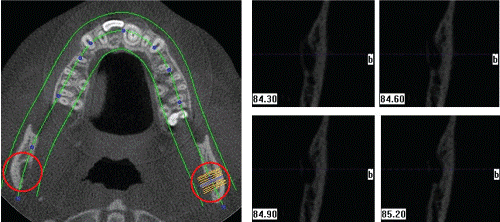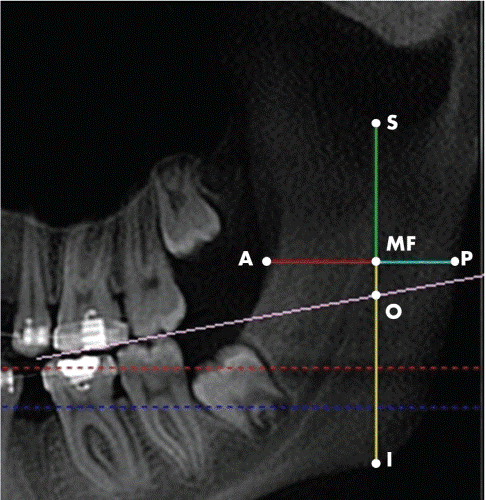Review Article Open Access
Three-Dimensional Analysis of Mandibular Foramen Location: A Cone Beam Computed Tomography Study
| Osman Sami A�?�?LARCI1*, Enes GÜNGÖR2, Mustafa ALTUNSOY3, Bilge NUR3, Evren OK4 and Mehmet ÇOLAK2 | |
| 1Department of Maxillofacial Radiology, Faculty of Dentistry, Sifa University, Turkey | |
| 2Department of Maxillofacial Radiology, Faculty of Dentistry, Dicle University, Turkey | |
| 3Department of Pediatric Dentistry, Faculty of Dentistry, Sifa University, Turkey | |
| 4Department of Endodontics, Faculty of Dentistry, Sifa University, Turkey | |
| Corresponding Author : | Osman Sami AGLARCI Department of Maxillofacial Radiology Faculty of Dentistry, Sifa University Ankara Cad. No: 45 35100, Bornova, Izmir, Turkey Tel: +90 532 5048054 E-mail: aglarci@gmail.com |
| Received December 15, 2014; Accepted February 08, 2015; Published February 11, 2015 | |
| Citation: A�?�?LARCI OS, GÜNGÖR E, ALTUNSOY M, NUR B, OK E, et al. (2015) Three-Dimensional Analysis of Mandibular Foramen Location: A Cone Beam Computed Tomography Study. OMICS J Radiol 4:179 doi:10.4172/2167-7964.1000179 | |
| Copyright: ©2015 A�?�?LARCI OS, et al. This is an open-access article distributed under the terms of the Creative Commons Attribution License, which permits unrestricted use, distribution, and reproduction in any medium, provided the original author and source are credited. | |
Visit for more related articles at Journal of Radiology
Abstract
Purpose: The mandibular foramen (MF) is the beginning of the mandibular canal located on the internal surface of the ramus mandible. The authors aimed to determine the three-dimensional position of MF to guide clinician for inferior alveolar nerve block and surgical procedures. Methods: CBCT images of 571 mandibular foramens from 286 patients (146 female, 140 male) aged between 8-69 years were evaluated. Up to the age of 18 were considered as growth group, and the others as adult group. Distances from midpoint of the MF to anatomic landmarks measured. Mann-Whitney U test, univariate varience of analysis and Spearman’s correlation were performed for the statistical comparisons. Results: MF is positioned nearly 1.58 mm behind the midpoint of the ramus horizontally 4.27 mm above the midpoint vertically. There were a significant difference for location of MF among gender, and for width, height and distance to occlusal plane between growth and adult groups. Measured distances were significantly correlated with age only in growth group. Clinical Significance Taking into consideration the anatomy and age of the patient may help better locate the MF for promoting successful and safe treatment procedures with reduced complications.
| Keywords |
| Mandibular anatomy; Mandibular foramen; CBCT; Inferior alveolar nerve |
| Introduction |
| Various anatomical landmarks are being used for surgical marks for some surgical procedures [1]. These anatomical landmarks that are related with mandible are significant and can be damaged during oral and maxillofacial surgical procedures like mandibular osteotomies, orthognathic surgeries, mandibular trauma managements, surgeries of benign and malignant lesions, implant surgeries, preprosthetic surgeries and also nerve damage is possible during inferior mandibular nerve block [2]. Mandibular Foramen (MF) is located on the medial aspect of the ramus which is important for being related directly to inferior alveolar nerve [1]. |
| Inferior Alveolar Nerve Block Anesthesia (IANBA) is the most frequently used nerve block technique in dental practice [3] IANBA is a fundamental for achieving local anesthesia for mandibular restorative and surgical procedures [4]. |
| Several reasons are nested in failure of anesthetic failure like operator application and technique, patient related factors like anatomical, psychological and/or pathological, and also anesthetics can be added with their content [5]. So the appropriate setting of the needle by the operator to the possible accurate location of MF is very important in success of anesthesia [6]. |
| CBCT provides high resolution images in three dimensions with low radiation dose. Accuracy of the studies evaluates anatomic structures of the maxillofacial region progress with the development of CBCT systems [7,8]. |
| The aim of this study is to clarify the landmarks that navigate operators for the most reliable and accurate approach while eliminating disrupting anatomical variations. |
| Materials and Methods |
| This retrospective study is conducted on CBCT scans of patients who visited Dicle University, Department of Oral and Maxillofacial Radiology between 2009 and 2012. The CBCT images were performed with the use of I-CAT Vision TM (Imaging Science International, Hatfield, USA, 2008) 8-9 seconds at 120 kVp and 18.54 mA with resolution of 536 × 536 and 0.3 mm-thick slices. An experienced radiologist acquired the images according to the manufacturer’s instructions. CBCT images of patients with edentulous mandibles, missing most of the teeth, a pathologic lesion causing asymmetry and deviation of the mandible were excluded from the study. CBCT images of 571 mandibular foramens gathered from patients with the age of 8-69 years. All patients had already undergone eruption of incisors and mandibular first molar and late 18 years of age were considered to have completed their physical growth. Therefore a growth group between the ages of 8 and 18 and an adult group between the ages of 19 and 69 were constituted. |
| The location of the MF was investigated from cross-sectional slices of CBCT images (Figure 1). The shortest distance from the midportion of MF to anterior border of the ramus (A), posterior border of the ramus (P), inferior point of the mandibular incisura -superior border of the ramus- (S), mandibular base-inferior border of the ramus-(I) and straight line of the cusps of the mandibular permanent molars (O) were measured in millimeters (Figure 2). Also the height (H) and the width (W) of MF were recorded. |
| Descriptive statistical analysis was conducted for the data for both groups. Homogeneity of the data was tested by Kolmogrov-Simirnov test. Univariate variance of analysis was performed for the statistical comparison between age groups, genders and sides. Differences between age groups and genders were tested by Mann-Whitney U test. Spearman correlation analysis was used to evaluate the relationship between the measurements. Statistical significance was estimated as p<0.05. |
| Results |
| The mean age and gender differences are given in the Table 1. The mean age of growth group was 12. 96 ± 3.22 and the adult group was 40.95 ± 13.88. Table 2 gives the values for each measurement of the distance between MF and the specific points. The mean distance from MF to anterior border of mandibula was 15.29 ± 2.60 mm and to the posterior border was 11.13 ± 2.44 mm, where the mean distance to the superior border was 16.70 ± 3.75 mm and to the inferior border was 24.75 ± 4.62 mm. The mean value for the MF height and MF width was 6.8 ± 1.8 mm and 5.9 ± 1.4 mm respectively. The lowest position of the occlusal plane was 4.80 mm below from the midpoint of MF, and the uppermost position was 19.80 mm above from the midpoint (Table 1 and 2) anterior, posterior, superior, inferior and occlusal plane distances, while MF height and width were same statistically. Between age groups only height, width and occlusal plane distances are found to be significantly different. There was a significant positive correlation between age and measurements only in growth group (Table 3). |
| Discussion |
| The knowledge of the MF position is of a cardinal importance for surgical procedures in dentistry and enables a more effective anesthesia that provides easier patient conditions [6]. Researchers have been studied to investigate the position of MF using dry mandibles and radiographic techniques such as panoramic, lateral oblique, cephalometric radiography and CT [1,3,9,10] Thanks to recent developments in CBCT technology, MF position investigation by using a 3-dimentional plane and measurement points has become easier [4]. CBCT provides an image produced has minimal unequal magnification and distortion and produces more reliable and accurate data with low radiation dose [2]. In the present study, the position of MF in 3-dimensions was measured relative to the structural landmarks in the oral cavity which can easily be referred for surgical procedures. |
| The authors found that the distance to anterior border was 15.29 mm, to the posterior border was 12.13 mm, to the superior border was 16.20 mm and to the inferior border was 24.75mm. This result clearly showed that MF is positioned nearly 1.58 mm behind the midpoint of the ramus horizontally 4.27 mm above the midpoint vertically. Thangaveu et al. [6] and Findik et al. [2] mentioned similar position for MF. |
| According to Lipski et al. [11] while the base and the alveolar part of the mandible are of same height, the MF moves cranially during growth. Among vertical measurements superior distance increase from 16.05 mm to 16.35 mm while inferior measurements increase from 23.61 mm to 26.38 mm between growth and adult groups. This means that MF moved cranially as Lipski et al. mentioned. Since mandibula grows in all directions, the size of ramus mandibula increases bodily. In the study a positive correlation between age and measurements was found in growth group while there were no correlations in adult group. Because by the end of growth, an increase in size is not expected. There were stronger correlations for some measurements. Posterior distance correlation is stronger than anterior one, and inferior is bigger to superior. This shows that the MF moves superiorly and inferiorly, and take position below and above the midpoint of the ramus. |
| The angle between the ramus and corpus of the mandible becomes more perpendicular; and the MF positions itself in the midpoint of the ramus [12]. During growth pattern mandibular angle decreases at the same time, and so distance to the occlusal plane increases up to senile ages. In our study distance to the occlusal plane is 3.47 mm in growth group while it is 7.28 mm in adult group. Due to the loss of teeth in senile ages, the size of mandible decreases and the mandibular ramus leans posteriorly, thus the mandibular angle increases [13,14]. In our study the mean distance from MF to the occlusal plane less than 7 mm after the age of 60. |
| The beginning of mandibular canal is wider than the other parts of the canal [15]. In the present study, while there were no significant differences among gender, width and height of the MF was different between adult and growth groups significantly. Besides this MF width and height are significantly correlated with age only in growth group. Thus MF widens until the end of growth, and does not change after that. |
| Conclusion |
| The present study represents that CBCT provides reliable information about the anatomy of mandibular and MF. Dimensions and position differences of MF were evaluated among gender and age groups. MF located just anterio-superior of the midpoint of the ramus and below the occlusal plane. As a limitation of the study, the anatomic measurements were not analyzed by race or ethnicity. Taking into consideration the anatomy and age of the patient may help better locate the MF for promoting successful and safe treatment procedures with reduced complications. In future more research conducted on CBCT technologies and wide patient groups are needed. |
References |
|
Tables and Figures at a glance
| Table 1 | Table 2 | Table 3 |
Figures at a glance
 |
 |
| Figure 1 | Figure 2 |
Relevant Topics
- Abdominal Radiology
- AI in Radiology
- Breast Imaging
- Cardiovascular Radiology
- Chest Radiology
- Clinical Radiology
- CT Imaging
- Diagnostic Radiology
- Emergency Radiology
- Fluoroscopy Radiology
- General Radiology
- Genitourinary Radiology
- Interventional Radiology Techniques
- Mammography
- Minimal Invasive surgery
- Musculoskeletal Radiology
- Neuroradiology
- Neuroradiology Advances
- Oral and Maxillofacial Radiology
- Radiography
- Radiology Imaging
- Surgical Radiology
- Tele Radiology
- Therapeutic Radiology
Recommended Journals
Article Tools
Article Usage
- Total views: 15983
- [From(publication date):
February-2015 - Aug 16, 2025] - Breakdown by view type
- HTML page views : 11162
- PDF downloads : 4821
